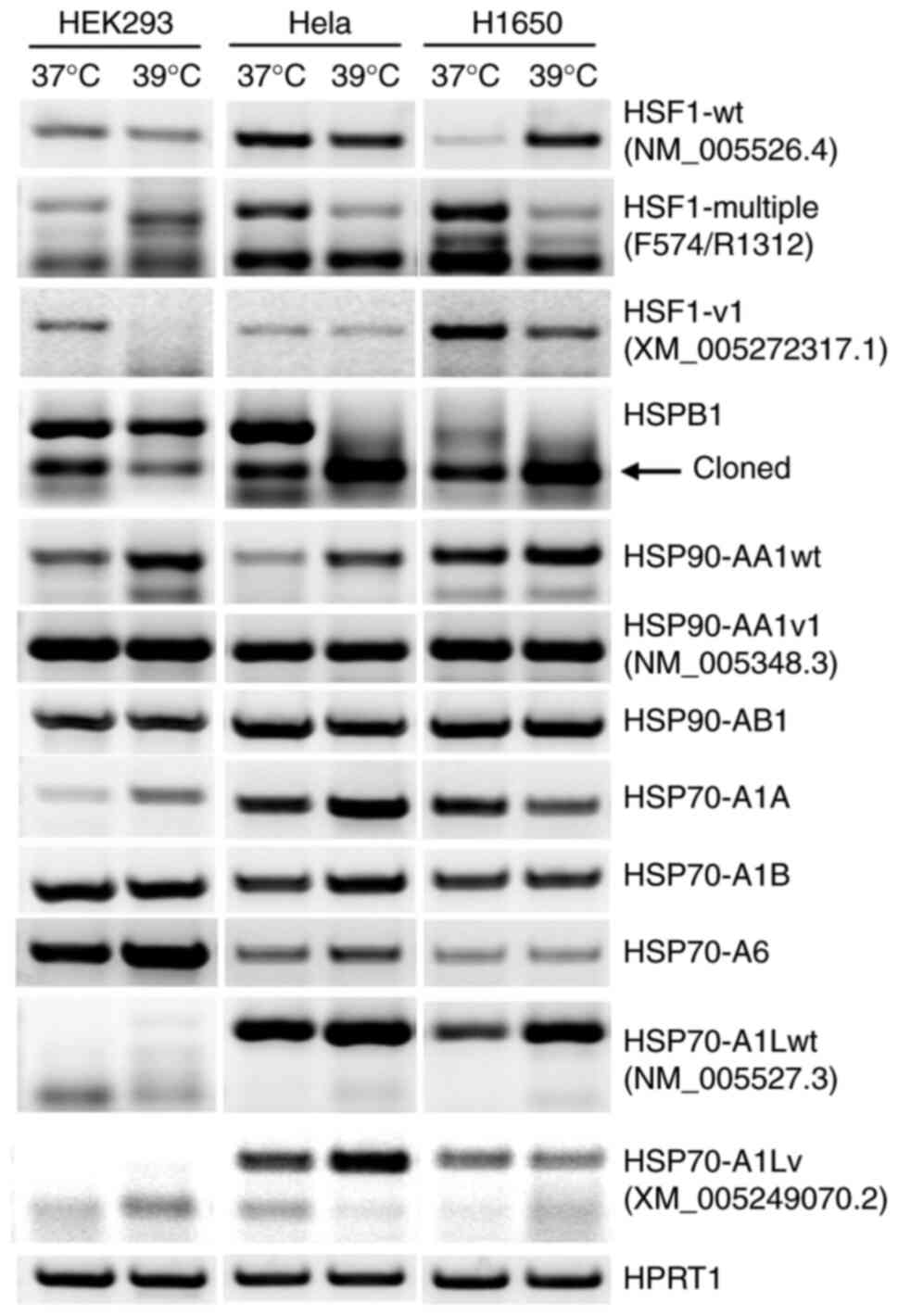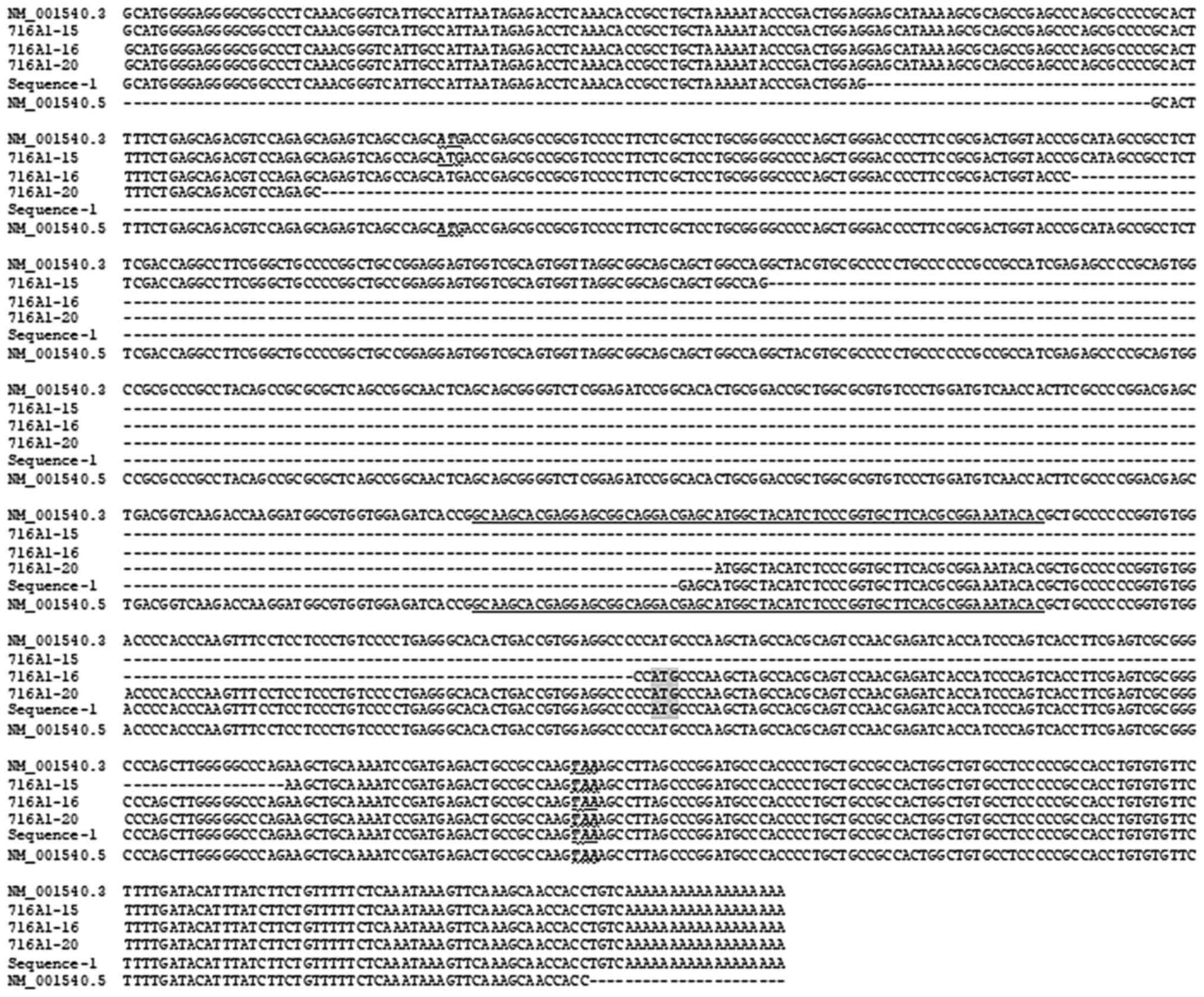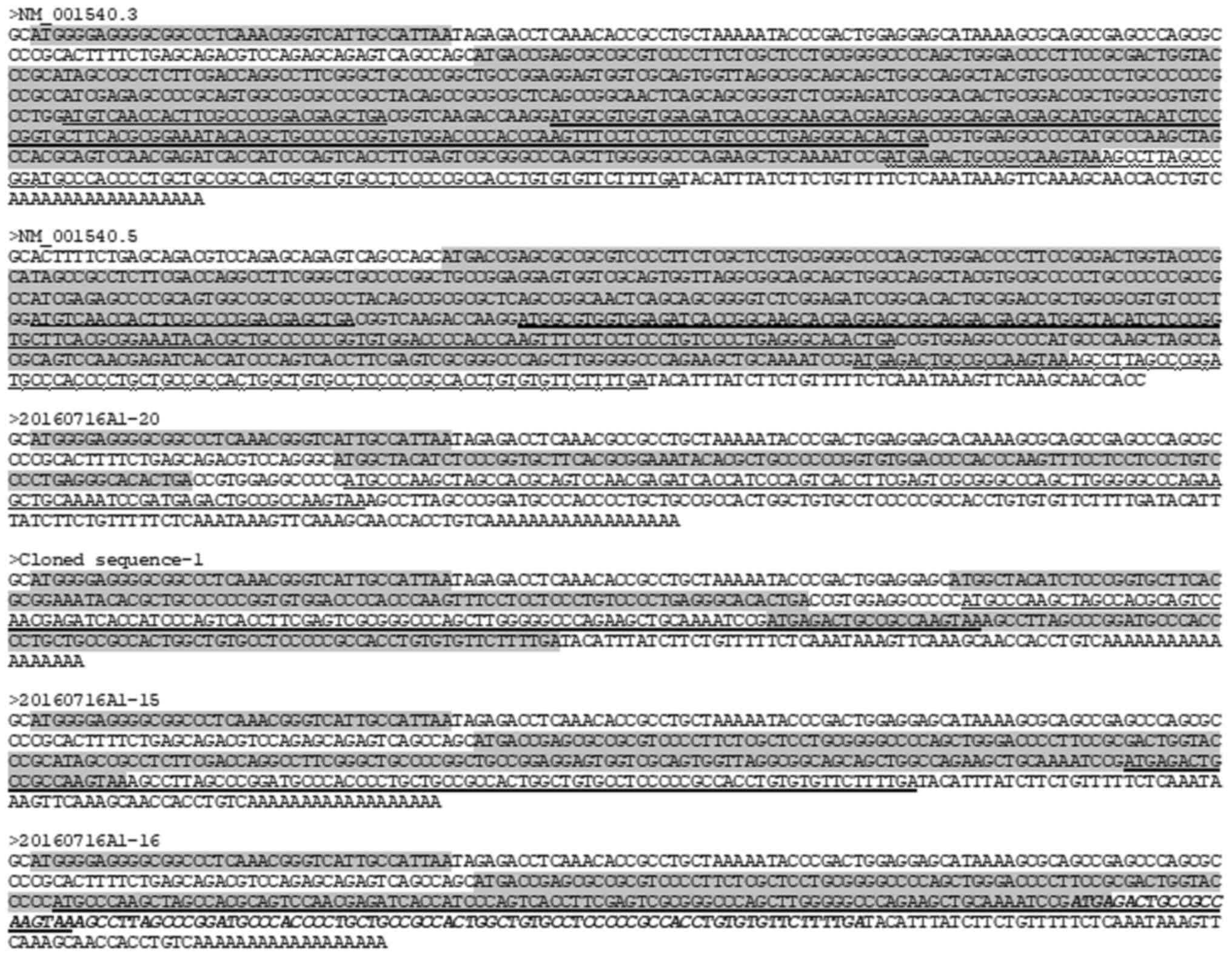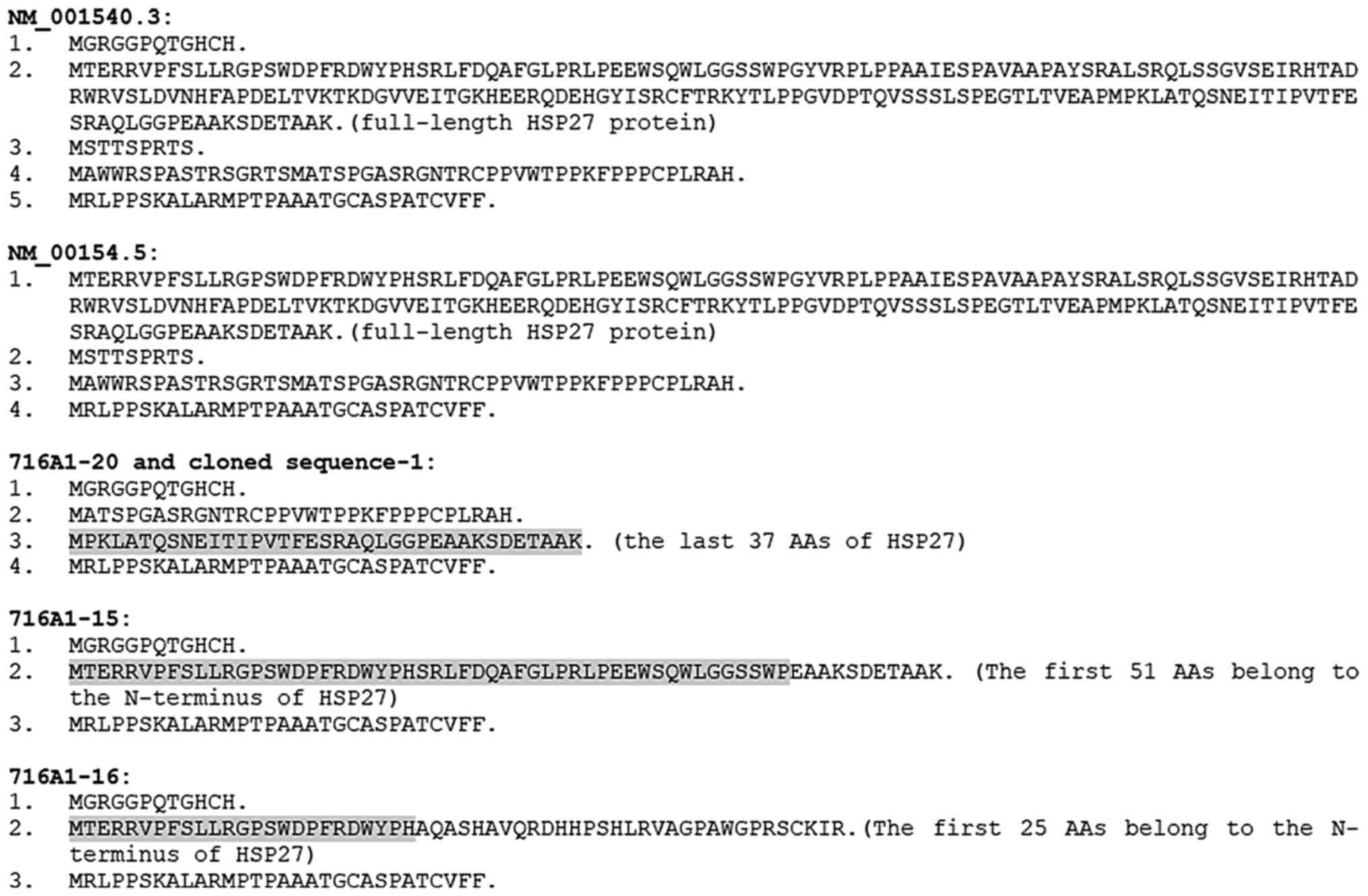|
1
|
Chaudhury S, Keegan BM and Blagg BSJ: The
role and therapeutic potential of Hsp90, Hsp70, and smaller heat
shock proteins in peripheral and central neuropathies. Med Res Rev.
41:202–222. 2021.PubMed/NCBI View Article : Google Scholar
|
|
2
|
Dabbaghizadeh A and Tanguay RM: Structural
and functional properties of proteins interacting with small heat
shock proteins. Cell Stress Chaperones. 25:629–637. 2020.PubMed/NCBI View Article : Google Scholar
|
|
3
|
Bascos NAD and Landry SJ: A history of
molecular chaperone structures in the protein data bank. Int J Mol
Sci. 20(6195)2019.PubMed/NCBI View Article : Google Scholar
|
|
4
|
Masser AE, Ciccarelli M and Andreasson C:
Hsf1 on a leash-controlling the heat shock response by chaperone
titration. Exp Cell Res. 396(112246)2020.PubMed/NCBI View Article : Google Scholar
|
|
5
|
Ahmed K, Zaidi SF, Mati-Ur-Rehman Rehman R
and Kondo T: Hyperthermia and protein homeostasis: Cytoprotection
and cell death. J Therm Biol. 91(102615)2020.PubMed/NCBI View Article : Google Scholar
|
|
6
|
Inia JA and O'Brien ER: Role of heat shock
protein 27 in modulating atherosclerotic inflammation. J Cardiovasc
Transl Res. 14:3–12. 2021.PubMed/NCBI View Article : Google Scholar
|
|
7
|
Prince TL, Lang BJ, Guerrero-Gimenez ME,
Fernandez-Munoz JM, Ackerman A and Calderwood SK: HSF1: Primary
factor in molecular chaperone expression and a major contributor to
cancer morbidity. Cells. 9(1046)2020.PubMed/NCBI View Article : Google Scholar
|
|
8
|
He Y, Yuan C, Chen L, Lei M, Zellmer L,
Huang H and Liao DJ: Transcriptional-Readthrough RNAs reflect the
phenomenon of ‘A Gene Contains Gene(s)’ or ‘Gene(s) within a Gene’
in the human genome, and thus are not Chimeric RNAs. Genes (Basel).
9(40)2018.PubMed/NCBI View Article : Google Scholar
|
|
9
|
He Y, Yuan C, Chen L, Liu Y, Zhou H, Xu N
and Liao DJ: While it is not deliberate, much of today's biomedical
research contains logical and technical flaws, showing a need for
corrective action. Int J Med Sci. 15:309–322. 2018.PubMed/NCBI View Article : Google Scholar
|
|
10
|
Jia Y, Chen L, Ma Y, Zhang J, Xu N and
Liao DJ: To know how a gene works, we need to redefine it first but
then, more importantly, to let the cell itself decide how to
transcribe and process its RNAs. Int J Biol Sci. 11:1413–1423.
2015.PubMed/NCBI View Article : Google Scholar
|
|
11
|
Liu X, Wang Y, Yang W, Guan Z, Yu W and
Liao DJ: Protein multiplicity can lead to misconduct in western
blotting and misinterpretation of immunohistochemical staining
results, creating much conflicting data. Prog Histochem Cytochem.
51:51–58. 2016.PubMed/NCBI View Article : Google Scholar
|
|
12
|
Qu J, Zhang J, Zellmer L, He Y, Liu S,
Wang C, Yuan C, Xu N, Huang H and Liao DJ: About three-fourths of
mouse proteins unexpectedly appear at a low position of SDS-PAGE,
often as additional isoforms, questioning whether all protein
isoforms have been eliminated in gene-knockout cells or organisms.
Protein Sci. 29:978–990. 2020.PubMed/NCBI View
Article : Google Scholar
|
|
13
|
Yan R, Zhang J, Zellmer L, Chen L, Wu D,
Liu S, Xu N and Liao JD: Probably less than one-tenth of the genes
produce only the wild type protein without at least one additional
protein isoform in some human cancer cell lines. Oncotarget.
8:82714–82727. 2017.PubMed/NCBI View Article : Google Scholar
|
|
14
|
Zhang J, Lou X, Shen H, Zellmer L, Sun Y,
Liu S, Xu N and Liao DJ: Isoforms of wild type proteins often
appear as low molecular weight bands on SDS-PAGE. Biotechnol J.
9:1044–1054. 2014.PubMed/NCBI View Article : Google Scholar
|
|
15
|
Taga A and Cornblath DR: A novel HSPB1
mutation associated with a late onset CMT2 phenotype: Case
presentation and systematic review of the literature. J Peripher
Nerv Syst. 25:223–229. 2020.PubMed/NCBI View Article : Google Scholar
|
|
16
|
Gao X, Zhang K, Lu T, Zhao Y, Zhou H, Yu
Y, Zellmer L, He Y, Huang H and Joshua Liao D: A reassessment of
several erstwhile methods for isolating DNA fragments from agarose
gels. 3 Biotech. 11(138)2021.PubMed/NCBI View Article : Google Scholar
|
|
17
|
Sun Y, Sriramajayam K, Luo D and Liao DJ:
A quick, cost-free method of purification of DNA fragments from
agarose gel. J Cancer. 3:93–95. 2012.PubMed/NCBI View
Article : Google Scholar
|
|
18
|
Sun Y, Cao S, Yang M, Wu S, Wang Z, Lin X,
Song X and Liao DJ: Basic anatomy and tumor biology of the RPS6KA6
gene that encodes the p90 ribosomal S6 kinase-4. Oncogene.
32:1794–1810. 2013.PubMed/NCBI View Article : Google Scholar
|
|
19
|
Sun Y, Lou X, Yang M, Yuan C, Ma L, Xie
BK, Wu JM, Yang W, Shen SX, Xu N and Liao DJ: Cyclin-dependent
kinase 4 may be expressed as multiple proteins and have functions
that are independent of binding to CCND and RB and occur at the S
and G 2/M phases of the cell cycle. Cell Cycle. 12:3512–3525.
2013.PubMed/NCBI View
Article : Google Scholar
|
|
20
|
Yang M, Sun Y, Ma L, Wang C, Wu JM, Bi A
and Liao DJ: Complex alternative splicing of the smarca2 gene
suggests the importance of smarca2-B variants. J Cancer. 2:386–400.
2011.PubMed/NCBI View Article : Google Scholar
|
|
21
|
Yang M, Wu J, Wu SH, Bi AD and Liao DJ:
Splicing of mouse p53 pre-mRNA does not always follow the ‘first
come, first served’ principle and may be influenced by cisplatin
treatment and serum starvation. Mol Biol Rep. 39:9247–9256.
2012.PubMed/NCBI View Article : Google Scholar
|
|
22
|
Yang W, Chen L, Yan F, Xie BK, Liao Y and
Liao DJ: Dirty plasmid used as a quick and low-cost method to
identify bacterial colonies with a recombinant plasmid. Indian J
Applied Res. 6(649)2016.
|
|
23
|
Wu J, Wu SH, Bollig A, Thakur A and Liao
DJ: Identification of the cyclin D1b mRNA variant in mouse. Mol
Biol Rep. 36:953–957. 2009.PubMed/NCBI View Article : Google Scholar
|
|
24
|
Bollig-Fischer A, Thakur A, Sun Y, Wu J
and Liao DJ: The predominant proteins that react to the MC-20
estrogen receptor alpha antibody differ in molecular weight between
the mammary gland and uterus in the mouse and rat. Int J Biomed
Sci. 8:51–63. 2012.PubMed/NCBI
|
|
25
|
Bazzini AA, Johnstone TG, Christiano R,
Mackowiak SD, Obermayer B, Fleming ES, Vejnar CE, Lee MT, Rajewsky
N, Walther TC and Giraldez AJ: Identification of small ORFs in
vertebrates using ribosome footprinting and evolutionary
conservation. EMBO J. 33:981–993. 2014.PubMed/NCBI View Article : Google Scholar
|
|
26
|
Cheng H, Chan WS, Li Z, Wang D, Liu S and
Zhou Y: Small open reading frames: Current prediction techniques
and future prospect. Curr Protein Pept Sci. 12:503–507.
2011.PubMed/NCBI View Article : Google Scholar
|
|
27
|
Kageyama Y, Kondo T and Hashimoto Y:
Coding vs non-coding: Translatability of short ORFs found in
putative non-coding transcripts. Biochimie. 93:1981–1986.
2011.PubMed/NCBI View Article : Google Scholar
|
|
28
|
Landry CR, Zhong X, Nielly-Thibault L and
Roucou X: Found in translation: Functions and evolution of a
recently discovered alternative proteome. Curr Opin Struct Biol.
32:74–80. 2015.PubMed/NCBI View Article : Google Scholar
|
|
29
|
Pauli A, Valen E and Schier AF:
Identifying (non-)coding RNAs and small peptides: Challenges and
opportunities. Bioessays. 37:103–112. 2015.PubMed/NCBI View Article : Google Scholar
|
|
30
|
Signal B, Gloss BS and Dinger ME:
Computational approaches for functional prediction and
characterisation of long noncoding RNAs. Trends Genet. 32:620–637.
2016.PubMed/NCBI View Article : Google Scholar
|
|
31
|
Jia H, Osak M, Bogu GK, Stanton LW,
Johnson R and Lipovich L: Genome-wide computational identification
and manual annotation of human long noncoding RNA genes. RNA.
16:1478–1487. 2010.PubMed/NCBI View Article : Google Scholar
|
|
32
|
Samudyata , Castelo-Branco G and
Bonetti A: Birth, coming of age and death: The intriguing life of
long noncoding RNAs. Semin Cell Dev Biol. 79:143–152.
2018.PubMed/NCBI View Article : Google Scholar
|
|
33
|
Yuan C, Han Y, Zellmer L, Yang W, Guan Z,
Yu W, Huang H and Liao DJ: It is imperative to establish a pellucid
definition of chimeric RNA and to clear up a lot of confusion in
the relevant research. Int J Mol Sci. 18(714)2017.PubMed/NCBI View Article : Google Scholar
|
|
34
|
Reisacher C and Arbibe L: Not lost in host
translation: The new roles of long noncoding RNAs in infectious
diseases. Cell Microbiol. 21(e13119)2019.PubMed/NCBI View Article : Google Scholar
|
|
35
|
Ruiz-Orera J, Messeguer X, Subirana JA and
Alba MM: Long non-coding RNAs as a source of new peptides. Elife.
3(e03523)2014.PubMed/NCBI View Article : Google Scholar
|
|
36
|
Chu Q, Ma J and Saghatelian A:
Identification and characterization of sORF-encoded polypeptides.
Crit Rev Biochem Mol Biol. 50:134–141. 2015.PubMed/NCBI View Article : Google Scholar
|
|
37
|
Kondo T, Hashimoto Y, Kato K, Inagaki S,
Hayashi S and Kageyama Y: Small peptide regulators of actin-based
cell morphogenesis encoded by a polycistronic mRNA. Nat Cell Biol.
9:660–665. 2007.PubMed/NCBI View Article : Google Scholar
|
|
38
|
Kondo T, Plaza S, Zanet J, Benrabah E,
Valenti P, Hashimoto Y, Kobayashi S, Payre F and Kageyama Y: Small
peptides switch the transcriptional activity of Shavenbaby during
Drosophila embryogenesis. Science. 329:336–339. 2010.PubMed/NCBI View Article : Google Scholar
|
|
39
|
Ladoukakis E, Pereira V, Magny EG,
Eyre-Walker A and Couso JP: Hundreds of putatively functional small
open reading frames in Drosophila. Genome Biol.
12(R118)2011.PubMed/NCBI View Article : Google Scholar
|
|
40
|
Chooniedass-Kothari S, Emberley E,
Hamedani MK, Troup S, Wang X, Czosnek A, Hube F, Mutawe M, Watson
PH and Leygue E: The steroid receptor RNA activator is the first
functional RNA encoding a protein. FEBS Lett. 566:43–47.
2004.PubMed/NCBI View Article : Google Scholar
|
|
41
|
Bogard B, Francastel C and Hube F:
Multiple information carried by RNAs: Total eclipse or a light at
the end of the tunnel? RNA Biol. 17:1707–1720. 2020.PubMed/NCBI View Article : Google Scholar
|
|
42
|
Yuan C, Xu N and Liao J: Switch of FANCL,
a key FA-BRCA component, between tumor suppressor and promoter by
alternative splicing. Cell Cycle. 11(3356)2012.PubMed/NCBI View Article : Google Scholar
|
|
43
|
Zhang D, Tang Z, Huang H, Zhou G, Cui C,
Weng Y, Liu W, Kim S, Lee S, Perez-Neut M, et al: Metabolic
regulation of gene expression by histone lactylation. Nature.
574:575–580. 2019.PubMed/NCBI View Article : Google Scholar
|




















